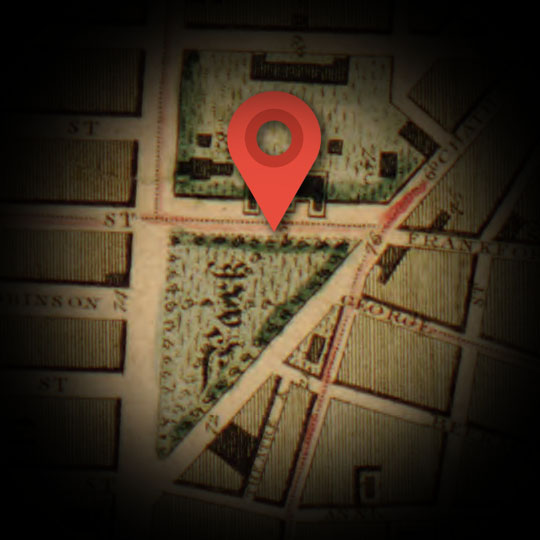THE COMMONS
Explore
As a New Yorker for much of his adult life, Alexander Hamilton didn’t just watch the city spread northward from its southern tip to occupy more and more of Manhattan Island. He participated in it—that is, by building The Grange, his Harlem home, way up on what would become 141st Street.
But when Hamilton first arrived in the city and lived there as a young man, this spot—today’s City Hall Park—was just about the northern terminus of the urban core.
What is now City Hall Park was, in Hamilton’s time, known as “The Commons” or “The Fields.” The idea or concept of a park for public recreation wasn’t really active in the 18th Century. But in the English-speaking world at least, places where people congregated to live in towns or villages often had public-access sites called “commons” where those of middling or low social status who did not possess land could pasture a few animals, like cows, or keep a vegetable garden. These sections of land belonged to everyone: the “common” folk, and thus the name.
The New York City Commons served a number of other public functions as well. It was not, like today, the home of City Hall (what would become Federal Hall). But the “Poor House” or “Alms House” was situated here. This was an asylum for the elderly, the ill, and the handicapped, and a work center as well for those who were able-bodied and able to earn their keep through various kinds of work. In 1772 it housed 425 people.
Part of the Commons was also the Muster Field or Parade Grounds where the militia would report for duty, for training, or as the name implied to parade on special occasions.
We know that Hamilton was on this spot at 6pm on July 9, 1776, for that was when General George Washington gave the first public reading of the Declaration of Independence in New York City.
A famous story follows this event. Afterwards, a large number of enthusiastic patriots marched downtown to another open area — Bowling Green (where the Alexander Hamilton Customs House stands today) — and tore down a gilded equestrian statue of King George III. Washington disapproved of this unsanctioned vigilante action and issued a stern public recrimination against those who had participated. It is a safe bet that Hamilton, a lover of law and order, was not among them.
The Commons is also where Hamilton’s first public speech is supposed to have taken place, portrayed in the musical in the number “My Shot.” However, there is no evidence whatsoever that Hamilton was at this July, 1774 rally, and definitely none that he spoke.
The location was, however, most assuredly the site of one important Hamilton speech. On April 22, 1796, Hamilton bravely waded into the turbulent political waters over the Jay Treaty—a widely and vociferously unpopular trade agreement with Great Britain negotiated by Hamilton’s friend and ally John Jay and signed by George Washington. Hamilton caught all kinds of heat for endorsing the treaty, and his position led to his being wounded by thrown rocks and challenged to a duel (which never came to fruition)

TIME FRAME:
1773-1804
